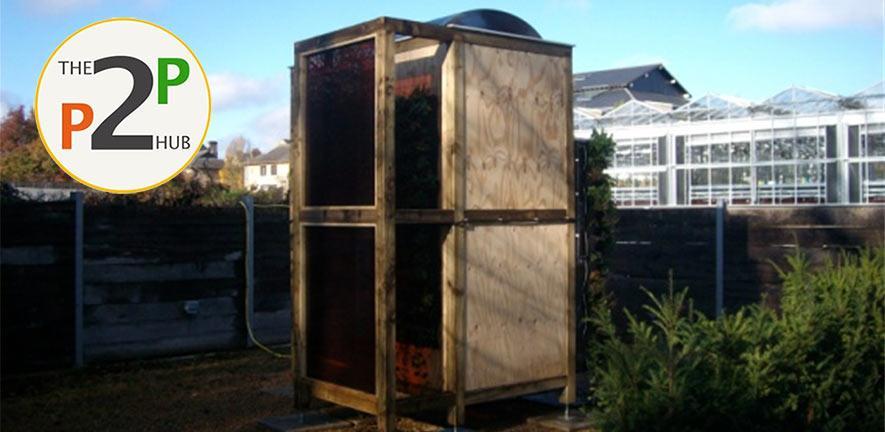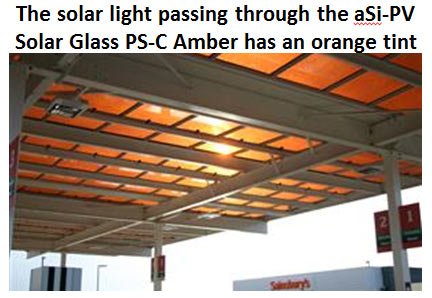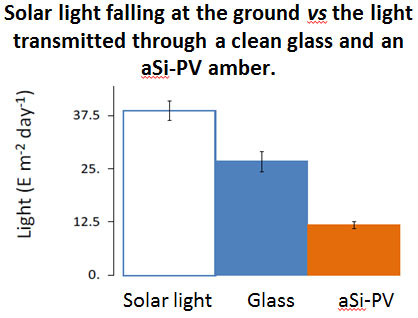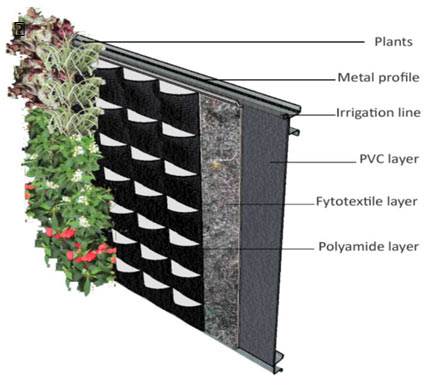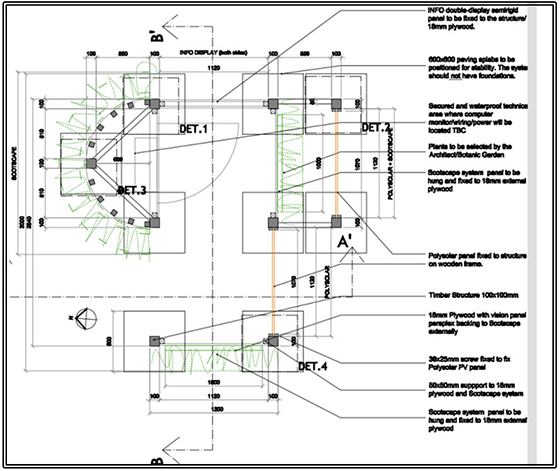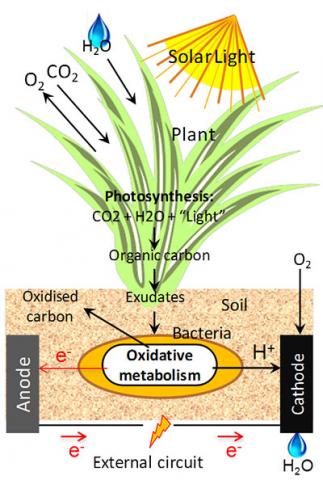The Plant to Power (P2P) solar hub was developed by a team from the Department of Plant Sciences in collaboration with green technology companies to generate electriity. The hub integrates two types of solar technologies:
The hub was displayed at the Botanic Garden for a year while the team monitored the amount of current produced by the combined system. The long-term aim of the project is to develop a range of self-powered sustainable buildings for diverse use all over the world from bus stops to refugee shelters. Below you can read more about the project from concept to build and install.
The Concept
The P2P aims to be an iconic architectural prototype that combines living wall, aSi-PV solar panels and plant-BES technologies in a single structure.
-
The sun shines on the P2P hub
-
The solar panels use some of the solar light (mainly UV, blue and green) for generating negative and positive charges. These charges are then recombined through an external circuit to create electrical current (see ① on diagram)
-
The living walls of plants photosynthesise, grow and release organic compounds into the soil
-
These organic compounds feed bacteria living in the soil around the plant roots
-
The bacteria in the soil oxidise the organic compounds, producing electrons which are collected by an anode, and protons which are collected by a cathode
-
These electrons and protons are recombined and travel through an external circuit to produce electrical current (see ② on diagram)
-
The electrical current generated in ① and ② are monitored
-
By integrating a-Si PV solar panels, living walls and plant-BES the P2P demonstrates how solar light can be used to generate electrical current by using and combining several different biological and non-biological technologies in a self-powering, sustainable system. It is demonstrated here as a bus shelter concept
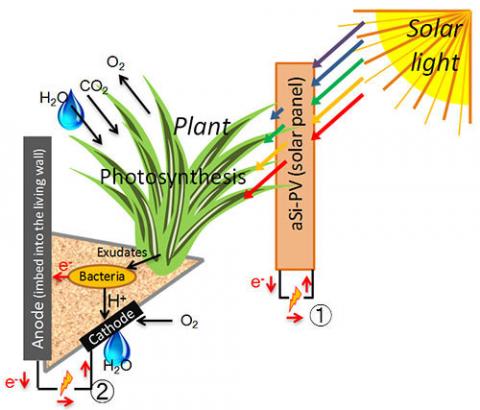
Planning
The final shape for the P2P hub has been designed by MCMM. The idea was to design a structure which looked like something commonly seen on urban streets - creating a familiar bridge between the P2P and the people that visit the installation. As the pictures below demonstrate the process of designing started from simple initial sketches and models, and progressed through 3D conceptual designs and ultimately was finalised through a series of detailed technical drawings.
Initial sketch
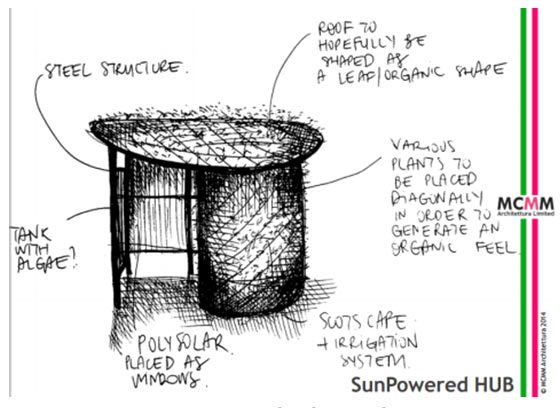
Initial model
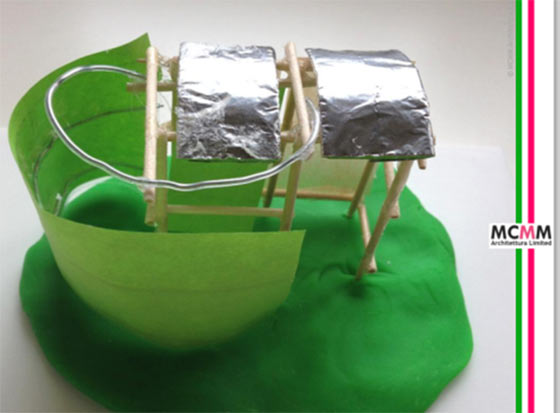
Conceptual design
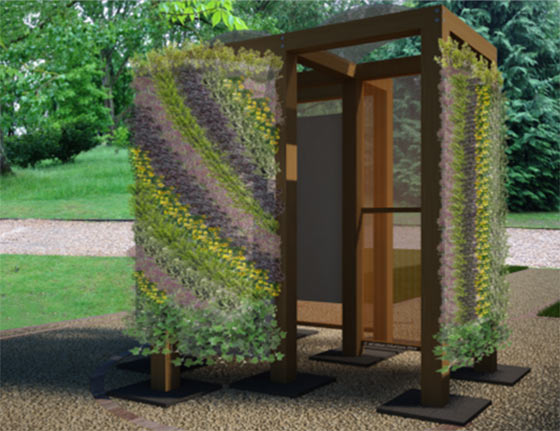
Front elevation
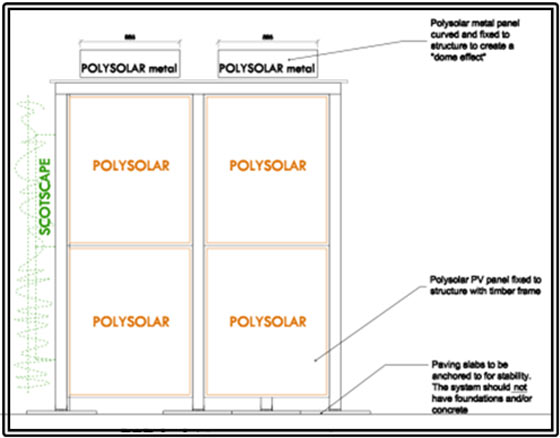
Side elevation
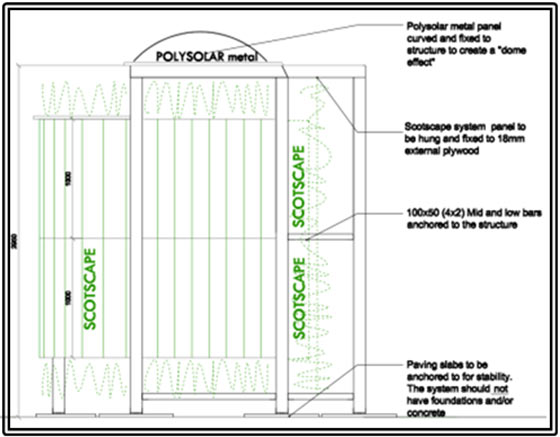
Rear elevation
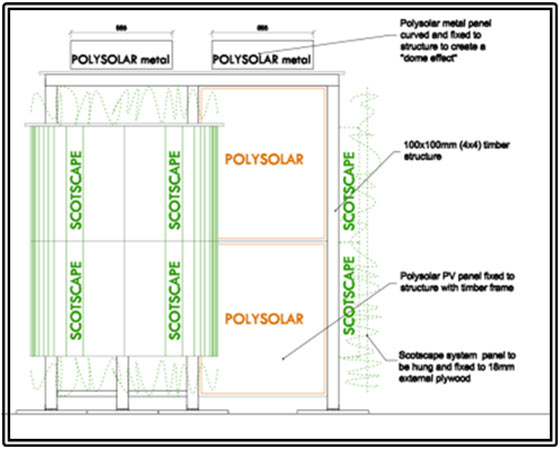
Floor plan/structure
Construction
The P2P has been built during November 2014. Willmott&Dixon was in charge for building the main structure.
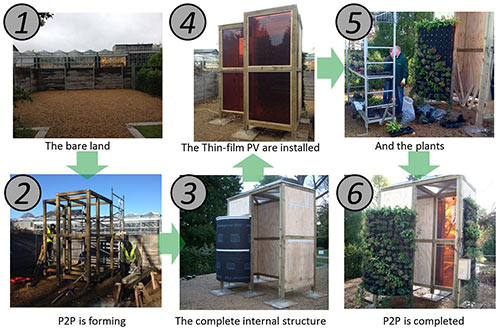
The Solar Panel
The solar panels used in the P2P are amorphous Silicon PV (aSi-PV). Polysolar uses Amorphous Silicon PV (aSi-PV) technology to manufacture photovoltaic solar glass. The material enables the production of transparent, chestnut opaque, and black solar PV panels, ideal for facades, canopies, skylights and curtain walls. Amorphous silicon technology uses the same silicon as the common crystalline silicon panels seen on many domestic roofs. The main difference is its molecular structure, which contains less silicon, and an irregular (amorphous) make-up.
Raw amorphous silicon is deposited as a thin, naturally translucent layer on a conductive glass substrate. The aSi-PV solar panels are manufactured by vacuum depositing an ultra-thin film of the PV absorber on a conductive TCO glass surface then laminating another glass sheet on top. The internal structure is shown below.
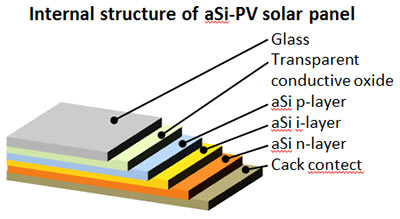
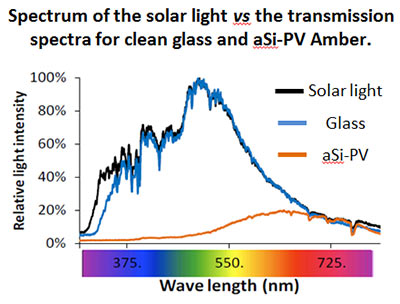
The aSi-PVs used in this project are Transparent Solar Glass PS-C Amber 95W BIPV Panel (facade) and Black Opaque Cladding PV PS-D 135W Solar Panel (roof). Some of the solar light can pass through the PS-C Amber panels. The picture above shows the transmission spectrum for the PS-C Amber panels (Orange trace) in comparison with the total solar light reaching the ground (Black trace) and the transmission spectrum of clean glass (Blue trace). This picture demonstrates that UV, Blue and Green light are almost completely absorbed by the aSi-PV solar panel whereas Yellow and Red can pass through. This gives to the transmitted light a characteristic orange tint as shown in the figure below.
The picture below shows that every day, one meter square of land receives ca. 38 Einstein of light (South of England, Summer 2014). In comparison, when the solar light is filtered through a clean glass and an aSi-PV Solar Glass PS-C Amber, the light transmitted is ca. 25 and 12.5 Einstein respectively.
Plant BES
Plant-BES is a plant bio electrochemical system that harnesses solar light and generates electrical current. In the P2P this technology has been housed inside the living wall.
Plant-BES exploits micro-organisms living in symbiosis with the plant roots to generate electrical current. This new technology is carbon neutral and combustion emission-free, and so it could potentially be used as a source of electricity in rural areas that have no access to electricity.
By using the local landscape, including food crops, to generate electricity through Plant BES, standard electricity infrastructure could be reduced and energy requirements brought into balance.. In the system described here, a plant harnesses light energy to power the photosynthetic machinery and releases organic compounds from its root system as by-products. Bacteria living in the soil consume the organic compounds to generate electrons. An anode in proximity with the soil bacteria collects the electrons. A cathode, wired to the anode by an external circuit, receives the protons and consumes the electrons by recombining them with oxygen to form water. To be recombined with protons, electrons travel through an external circuit where the electrical current is made.
The Living Wall of the P2P
A Living Wall is a wall partially or completely covered with vegetation. Living Walls are also known as Green Walls, Bioboards, Biowalls, Ecowalls, or Vertical gardens. The Living Walls may be indoors or outside, freestanding or attached to an existing structure. Living Walls have seen a recent increase in popularity and Scotscape has contributed to this trend by creating iconic Living Walls. The pictures right testify this commitment.
Living Walls go further than simply aesthetic benefits. Living Walls can act as living insulation (both acoustic and thermal). Not only do they cool the ambient air temperature and reduce the Heat Island effect, they can even have a cooling effect upon the building the system is attached to. Glare is also significantly reduced when compared with standard hardscaped walls. The advantages of a Living Wall system also extends to the biodiversity. The variety of plant species within these Living Walls provides unique possibilities for habitat preservation and the protection of local flora and fauna, even within an urban setting. Rare urban habitats can be created for birds, bees and insects and we can advise on the suitable mix and location of nesting boxes and hives. Moreover, plants help remove harmful PM 10’s (Particulate Matter) and nitrogen dioxide from the air, thus contributing to the overall health and sense of wellbeing of everyone.
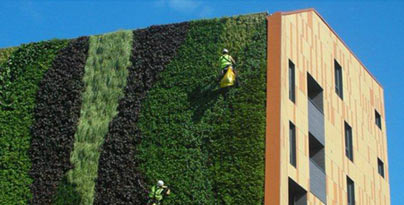
The Scotscape Living Wall is a light-weight semi hydroponic modular panel system constructed from a patented advanced geotextile fabric. Each square metre holds 49 plants in individual pockets. Each panel incorporates a dripline to irrigate the plants through the fabric. Panels can be fitted to flat or curved surfaces and are planted on site. The system is designed for rapid installation by a small specialist team, minimizing on-site disruption and downtime. Every part of the module is made with recycled materials and is itself recyclable. The module is composed by several layers that includes PVC layer, Fytotextile layer and Polyamide layer as shown below.
Prototype
The P2P is an architectural prototype which combines living wall, solar panel and plant-BES technology. In the P2P renewable energy in the form of electricity is generated by 14 units (6 aSi-PV solar panels and 8 living wall/plant-BES) as shown below.The P2P is located in Cambridge at the Botanic Garden (at the site 25).
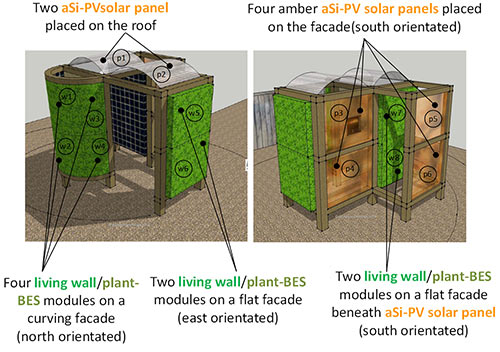
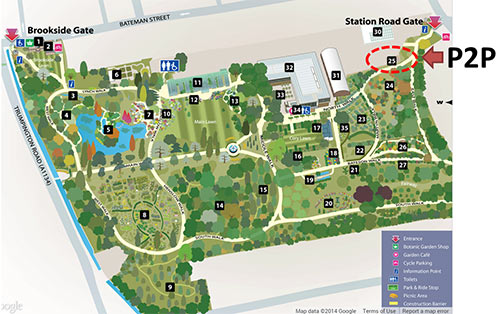
Publications
-
McCormick AJ, Bombelli P, Bradley RW, Thorne R, Wenzel T, Howe CJ (2015) Biophotovoltaics: oxygenic photosynthetic organisms in the world of bioelectrochemical systems. Energ Environ Sci. In press
-
Bombelli P, Mueller T, Herling TW, Howe CJ, Knowles TPJ (2014) A high power-density mediator-free microfluidic biophotovoltaic device for cyanobacterial cells. Advanced Energy Materials DOI: 10.1002/aenm.201401299
-
Bradley RW, Bombelli P, Lea-Smith DJ, Howe CJ (2013) Terminal oxidase mutants of the cyanobacterium Synechocystis sp. PCC6803 show increased electrogenic activity in biological photo-voltaic systems. Phys. Chem. Chem. Phys. 15:13611-13618.
-
McCormick AJ, Bombelli P, Lea-Smith DJ, Bradley RW, Scott AM, Smith AG, Fisher AC and Howe CJ (2013) Hydrogen production through oxygenic photosynthesis using the cyanobacterium Synechocystis sp. PCC 6803 in a bio-photoelectrolysis cell (BPE) system. Energ Environ Sci. 6:2682-2690.
-
Bombelli P, Iyer DMR, Covshoff S, McCormick AJ, Yunus K, Hibberd JM, Fisher AC and Howe CJ (2012) Comparison of power output by rice (Oryza sativa) and an associated weed (Echinochloa glabrescens) in vascular plant bio-photovoltaic (VP-BPV) systems. Applied Microbiology and Biotechnology 97:429-438.
-
Bradley RW, Bombelli P, Rowden SJL and Howe CJ (2012) Biological Photovoltaics: Intra- and Extra-cellular Electron Transport by Cyanobacteria. Biochem Soc Trans. 40: 1302-1307.
-
Bombelli P, Zarrouati M, Thorne RJ, Schneider K, Rowden SJL, Ali A, Yunus K, Cameron PJ, Fisher AC, Wilson DI, Howe CJ, McCormick AJ (2012) Surface morphology and surface energy of anode materials influence power outputs in a multi-channel mediatorless bio-photovoltaic (BPV) system. Phys Chem Chem Phys DOI:10.1039/C2CP42526B.
-
McCormick AJ, Bombelli P, Scott AM, Philips AJ, Smith AG, Fisher AC, Howe CJ (2011) Photosynthetic biofilms in pure culture harness solar energy in a mediatorless bio-photovoltaic (BPV) cell system. Energ Environ Sci 4:4699-4709.
-
Bombelli P, Bradley RW, Scott AM, Philips AJ, McCormick AJ, Cruz SM, Anderson A, Yunus K, Bendall DS, Cameron P, Davies J, Smith AG, Howe CJ, Fisher AC (2011) Quantitative analysis of the factors limiting solar power transduction by Synechocystis sp. PCC 6803 in biological photovoltaic devices. Energ Environ Sci 4:4690-4698.
